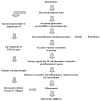Omega-3 and renal function in older adults
- PMID: 20041816
- PMCID: PMC2863302
- DOI: 10.2174/138161209789909719
Omega-3 and renal function in older adults
Abstract
Chronic kidney disease (CKD) is a major public health problem and can result in end-stage renal disease with need for dialysis or transplantation. In Europe up to 12% of the adult population had some renal impairment, while in the United States the end stage of CKD has increased dramatically from 209.000 in 1991 to 472.000 in 2004. Diabetes and hypertension are major causes of kidney pathology. Infection, particularly ascending infection, is more common with increasing age, as both immune function declines and associated pathology predisposing to infection, such as obstructive uropathy, becomes more common. Most pathological changes in the kidney appear to be initiated by oxidative stress, followed by an inflammatory reaction. Oxidative stress results from an imbalance between free radicals and their detoxification by endogenous and exogenous scavengers, including polyunsaturated fatty acids (PUFA). Recent studies showed that PUFA supplementation slowed the rate of loss of renal function in patients with IgA nephropathy. Then, studies of omega-3 supplementation in dialysis patients describe salutary effects on triglyceride levels and dialysis access patency. We examined the relationship between total plasma PUFA levels and change in creatinine clearance over a three-year follow-up in the older persons enrolled in the InCHIANTI study, a population-based epidemiology study conducted in Tuscany, Italy. This study showed that older adults with low total plasma PUFA levels have a greater decline in creatinine clearance over three years of follow-up. These findings suggest that a higher dietary intake of PUFA may be protective against progression to chronic kidney disease.
Figures
Similar articles
-
Effects of omega-3 polyunsaturated fatty acid intake in patients with chronic kidney disease: Systematic review and meta-analysis of randomized controlled trials.Clin Nutr. 2020 Feb;39(2):358-368. doi: 10.1016/j.clnu.2019.02.041. Epub 2019 Mar 14. Clin Nutr. 2020. PMID: 30905498
-
Omega-3 Polyunsaturated Fatty Acid Supplementation to Prevent Arteriovenous Fistula and Graft Failure: A Systematic Review and Meta-analysis of Randomized Controlled Trials.Am J Kidney Dis. 2018 Jul;72(1):50-61. doi: 10.1053/j.ajkd.2017.11.017. Epub 2018 Feb 12. Am J Kidney Dis. 2018. PMID: 29395485
-
Omega-3 fatty acid supplementation in advanced kidney disease.Semin Dial. 2010 Jul-Aug;23(4):396-400. doi: 10.1111/j.1525-139X.2010.00748.x. Semin Dial. 2010. PMID: 20701719 Review.
-
The effect of n-3 fatty acids on C-reactive protein levels in patients with chronic renal failure.J Ren Nutr. 2007 Jul;17(4):258-63. doi: 10.1053/j.jrn.2007.03.003. J Ren Nutr. 2007. PMID: 17586424 Clinical Trial.
-
Supplementation with omega-3 polyunsaturated fatty acids and experimental tacrolimus-induced nephrotoxicity.Exp Clin Transplant. 2014 Dec;12(6):522-7. Exp Clin Transplant. 2014. PMID: 25489802
Cited by
-
Current nutritional recommendations and novel dietary strategies to manage sarcopenia.J Frailty Aging. 2013;2(1):38-53. J Frailty Aging. 2013. PMID: 26082911 Free PMC article.
-
Effect of six different cooking techniques in the nutritional composition of two fish species previously selected as optimal for renal patient's diet.J Food Sci Technol. 2015 Jul;52(7):4196-205. doi: 10.1007/s13197-014-1474-8. Epub 2014 Jul 26. J Food Sci Technol. 2015. PMID: 26139884 Free PMC article.
-
Beneficial Effects of 6-Month Supplementation with Omega-3 Acids on Selected Inflammatory Markers in Patients with Chronic Kidney Disease Stages 1-3.Biomed Res Int. 2017;2017:1680985. doi: 10.1155/2017/1680985. Epub 2017 Nov 19. Biomed Res Int. 2017. PMID: 29349065 Free PMC article.
-
Effectiveness of omega-3 supplement on lipid profile and lipid peroxidation in kidney allograft recipients.Nephrourol Mon. 2013 Jul 1;5(3):822-6. doi: 10.5812/numonthly.9384. Epub 2013 Jun 20. Nephrourol Mon. 2013. PMID: 24282793 Free PMC article.
-
Associations between dairy food consumption and chronic kidney disease in older adults.Sci Rep. 2016 Dec 20;6:39532. doi: 10.1038/srep39532. Sci Rep. 2016. PMID: 27996057 Free PMC article.
References
MeSH terms
Substances
Grants and funding
LinkOut - more resources
Full Text Sources
Other Literature Sources
Medical
Miscellaneous



